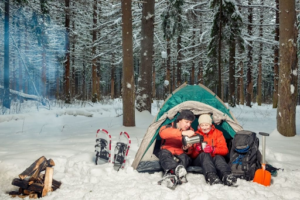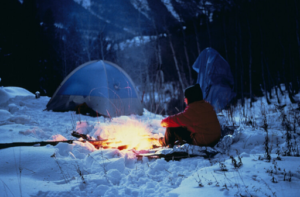Have you ever wondered what it feels like to wake up in a peaceful winter wonderland? Camping in the winter sounds interesting for any campers who have the passion for challenging with new experience. But how to keep warm when the weather outside is freezing? Here are a few tips how to insulate a tent for winter camping.
Why is Insulating Your Tent Critical for Winter Camping?
When camping in the winter, it is essential to know how to insulate your tent to prevent hypothermia and help you sleep well at night. As hypothermia happens when you’re at 98.6 degrees Fahrenheit, you must know how the cold air moves into the tent.
Due to convection, tents become cold and when cold air moves inside, it gets warmer as soon as it exposes your body. This is when condensation and moisture happens, which can get more serious if it’s raining outside your tent.
As a result, mildew and mold have the perfect environment to develop, which can be dangerous for those having allergies or asthma.
Therefore, insulated tents can keep you warm and prevent moisture. These are a few tips to insulate your tent and help you stay warm all night long.
Different Ways To Insulate a Tent for Winter Camping
How To Insulate A Tent: Picking the Right Tent for Winter Conditions
One of the most fundamental things to consider when choosing tents is picking a four-season tent instead of a three-season one. While three-season tents are lightweight with a mesh canopy for breathability, four-season tents have thicker inner lining to keep you warm. They also have more pegs and anchor ropes to improve stability.
Another important criteria to consider is the size. Try to get one as small as possible because the smaller the tent, the more heat that stays near you. Although it is comfortable to stay in a large one, it will waste heat on the added space.

Setting Up on a Strategic Spot for Optimal Warmth
Choose where to pitch your tent wisely. Avoid where the wind blows directly to. Try to camp near trees or and large rocks to reduce icy winds from reaching your tent. These things will act as natural windbreak.
If there are no trees or shelters nearby, try to set your tent up so the wind could only blow around rather than directly to your tent. In case you’re camping in a valley, make sure there are no low spots for the wind to gather and affect your tent.
Ground Insulation: A Must-Have for Winter Camping
Insulate the floor of your tent with a ground mat, rug or a blanket. This will reduce cold air seeping into your bones so you could sleep comfortably and enjoy your camping trips.
If possible, buy a sleeping mat which is specially designed to keep you warm without touching the cold winter ground.
Building a Snow Windbreak: A Simple Yet Effective Method
If you cannot camp near natural windbreaks, bring along a canopy or a windscreen, which you could use to stop the cold air from reaching your tent. You can also use a portable ice shelter to protect you from icy environments.
In case you don’t have anything with you, pull one side of the tarp down and stake it into the ground to create a lean-to which acts as a windbreak.
This helps lock in more heat and keep the icy winds away.
Covering Up Your Tent: A Layered Approach to Insulation
Bring along a waterproof rain fly, tarp or cover not only to prevent dew, frost and snow out, but also helps lock heat in.
Before heading up to your trip, test your rain fly first by spraying it with the hose to check whether it’s waterproof.
If you don’t have a waterproof cover at home, buy one! It not only helps fog, rain, snow slide off but also acts as a lean-to, windbreak or ground cover.

Don’t Neglect the Top of Your Tent: Thermal Blankets to the Rescue
The top of your tent is important and once inside and all zipped up for the night, use dutch tape to fix the thermal blankets across the top of your tent. With a reflective foil coating that minimizes heat loss, it helps to reflect your body temperature back down to you and always retain the heat that is generated inside the tent to keep you warm.
You can also use it in case of emergency so make sure to buy two: one for your tent and one for the first aid kit.
Keeping Yourself Warm: What to Wear for Winter Camping
Insulating your tent is not enough, you also need to consider what to wear on winter camping trips. The biggest challenge is definitely dressing up in layers. Thermal underwear will be a perfect choice because they are cheap, snuggly with all sizes and colors. Pack thermal socks with you but remember to bring a few pairs for backup. You don’t want to have cold wet feet throughout the trip, right?
Heating Solutions for Your Tent: From Hot Rocks to Tent Heaters
To keep your tent warm, use hot rocks as a heat source. Put them inside your tent and remember to carefully cover it with a towel or cloth to prevent the heat from escaping. This could help to radiate heat towards the ceiling to keep you warm inside.
If you’re camping where the temperature drops below freezing, buy a tent heater. It is easily purchased in any camping store, inexpensive but retains your body heat throughout the nights.

Insulating the Floor of Your Tent: Foam Pads, Rugs, and Carpets
Most tents have built-in ground but if yours don’t have one, you can use foam pads as a makeshift floor to provide a proper insulation for your tents.
Another solution is using rugs or carpets to cover the ground inside your tents. You can also make use of it as an extra layer if it’s rainy outside to insulate the tent better while you can sleep comfortably.
Wearing Something on Your Head: An Often-Overlooked Tip
The top of our head is where we lose most of our body heat, so a knit hat or a balaclava will help you stay warm. Not only your head but it can also keep your ears warm to ensure a perfect sleep at night.
Keeping Your Sleeping Bag Warm: Heat Packs and Warm Sleeping Bags
One of the perfect and necessary things on your checklist is the heat packs. Despite being small and lightweight, they can retain heat inside for up to 12 hours when placed around or in your tent. Avoid touching directly with your skin, you can wrap it in towels and blankets or use them inside your sleeping bags or clothing.

Avoiding the Cold: Wind Breaks from The Snow
It is surprising that you can use snow to keep your tent warm! Sounds strange, right? By building a wall of snow, you can block icy winds from hitting directly your tent. Look for the softest snow on the leeward side of the mountain or hills nearby, pack them into blocks and build a wall of snow until it reaches your waist. This is a perfect height to prevent it from collapsing. Once you’ve done, throw some snow on top for extra insulation.
Conclusion
Although winter camping might not be familiar, it is a perfect time for you to hit the trail and enjoy your memorable trip. However, you need to be well-prepared to have a wonderful experience gazing at nature and prevent yourself from facing natural challenges that might affect your physical health. We hope that these few tips can help you how to insulate a tent and keep yourself warm for the upcoming winter trip.
